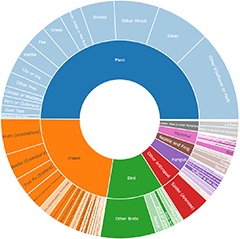Bees (Hymenoptera, Apiformes)
An introduction to Australian Native Bees can be found here:
https://www.aussiebee.com.au/beesinyourarea.html
The identification of bees from photographs can be difficult as tiny details on the animals have to be seen. Michael Batley, our moderator for bees has begun a trial identification tool for bees. The test groups are Megachilid bees and Hylaeine bees found in the Sydney basin and Blue Mountains.
If you want to try the identification tools, the addresses for the two groups are below:-
Announcements
There are currently no announcements.
Discussion
PeterA
wrote:
Yesterday
Great image, Tim. I think it is L. erythurum, but it might also be L. hemichalceum - they are hard to separate. The thorax can vary from black to bright metallic green. The lighter abdomen suggests L. erythurum, but the dark patch on T1 and the darker legs suggest L. hemichalceum.
I see the mites now you point them out!
Michael?
I see the mites now you point them out!
Michael?
Lasioglossum (Chilalictus) erythrurum
MichaelMulvaney
wrote:
18 Sep 2025
Actually Kylie in a citizen science naturemapr assisted study of Canberra's pollinators we found that 79% of the recorded flower visitations by the European bee were on exotic flowers. But I don't want to sing their virtue as the European bees was a major pollinator of several weed species including Echium species (53% of all recorded visitations on this genus), Spear Thistle (Cirsium vulgare - 50%), St John’s Wort Hypericum perforatum - 30%) and the Dandelion Group (17%).
Apis mellifera
PeterA
wrote:
15 Sep 2025
Great pictures. Probably L. hiltacus, but hard to be sure.
Lasioglossum (Parasphecodes) sp. (genus & subgenus)
Significant sightings
- Xylocopa (Lestis) aerata at Acton, ACT
- Xylocopa (Lestis) aerata at Acton, ACT
- Leioproctus (Andrenopsis) wilsoni at Bruce, ACT
- Xylocopa (Lestis) aerata at Yarralumla, ACT
- Hylaeus (Euprosopoides) perplexus at Murrumbateman, NSW
- Megachile (Rhodomegachile) deanii at Acton, ACT
- Xylocopa (Lestis) aerata at Acton, ACT
- Xylocopa (Lestis) aerata at Theodore, ACT
- Xylocopa (Lestis) aerata at Acton, ACT
- Xylocopa (Lestis) aerata at Gundaroo, NSW
Top contributors
- kasiaaus 343
- AlisonMilton 259
- KylieWaldon 242
- PeterA 235
- TimL 227
- Roger 191
- HelenCross 163
- Hejor1 131
- LisaH 128
- RodDeb 122
Top moderators
- michael.batley 2.9K
- PeterA 931
- MichaelMulvaney 385
- DiBickers 257
- MichaelBedingfield 252
- donhe 43
- KimPullen 21
- Curiosity 14
- abread111 9
- CharlesDove 9











































